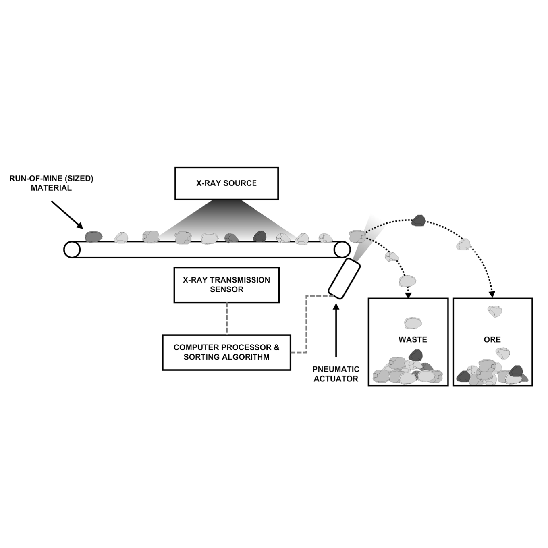Shahroud copper ore beneficiation plant
The optimization of the Shahroud copper ore beneficiation plant by using of physical preconcentration X-ray sorting method
icon
ABSTRACT
The aim of this investigation is the evaluation of optimizing the beneficiation plant of the Shahroud copper ore near the city of Shahroud in Iran, by using of sensor-based ore sorter that applies X-ray transmission technology. Currently, the mentioned plant with a feed capacity of 52t/h produces 0.5t/h copper concentrate with grade of 30% and copper recovery of 85% from a feed grade of 0.36%. By applying an X-ray transmission-based (XRT) sorter, it is possible to preconcentrate the feed and remove the gangue materials before entering the plant. Therefore, production rate of concentrate can be increased. In this study, the obtained representative sample from plant was preconcentrated in particle size of -75+10mm by using of X-ray sorter and then, the concentrate with Cu grade of 0.85% was obtained. Therefore, by using of X-ray sorter the Cu grade of plant feed was increased to 0.48%. By increasing the feed grade from 0.36% to 0.48%, and considering of Cu recovery of 85%, the production rate will be increased from 0.48t/h to 0.61t/h. Therefore, the preconcentration by using of XRT sorter increases the production rate by 27%.
Introduction
Ore sorting is a class of technology that identifies those stones in a ROM stream that contain economically viable levels ore for further processing and separates them from the gangue (Lessard et al., 2014; Kern et al., 2019; Newton, 1959; Wills, 1992).Sorting is an age-old practice, with hand-picking performed in the medieval workshops of alchemists (Agricola, 1556) through to modern picking tables at coal mines and fluorescent picking at tungsten deposits using visual assessment of individual mined rocks to categorize each as either ore or waste on the basis of physical appearance and properties of each rock, such as: luster, color, shape, weight, or texture (Bamber, 2008). For such small, early, high grade mines, the benefits of hand sorting were obvious (Kelly et al., 1995; Wills, 1992). However, as grades decreased, production scales increased with new approaches such as mechanized mining, and sorting, failing to offer required capacity was abandoned as an approach until the advent of sensor-based ore sorting in the 1920s (Michael, 2015; Robben and Wotruba, 2019)..By separating the ROM stream into ore and waste fractions, downstream processing is positively affected. The ore fraction is a higher grade material than the original ROM feed. This in return reduces the energy consumed in comminution, reduces resource and reagent consumption, and improves performance in downstream processes (Allen and Gordon, 2009; Dalmijn and de Jong, 2004; Harbeck, 2004; Lessard et al., 2014; Riedel, 2006).There are few examples of the application of sorting in the metal mining industry like the installation of an Ultrasort conductivity sorter at Kambalda in Western Australia (Goode, 2006; Wills, 1992). Introduced in the 1930s and 1940s, the technology first took root in mining applications with relatively simple sorting criteria, low throughput, and high value minerals and metals (Anonymous, 1971; Coulson, 2012; Salter and Wyatt, 1991; Sivamohan and Forssberg, 1991).The manner in which the ore sorting is performed is largely dependent on the minerals to be sorted. To date several different technologies have been investigated and piloted, including X-ray fluorescence, X-ray transmission, electromagnetic, Laser, radiometric sorting, and optical sorting (Li et al., 2020; Knapp et al., 2014; Manouchehri, 2003; Robben et al., 2020). The economic impact of ore sorting has been studied by several authors, to varying degrees. De Jong (2005) outlined many of the qualitative benefits of the technology as applied to various minerals or ores through pilot studies (De Jong, 2005). Another qualitative approach taken by Ballantyne identified the practical limitations to ore sorting from a particle size versus power savings perspective (Ballantyne et al., 2012). Lessard examined a specific though hypothetical case involving molybdenum mining to show that savings potentials amounted to nearly 60% reduction in comminution energy per ton of molybdenum produced (Lessard et al., 2014).


No comment